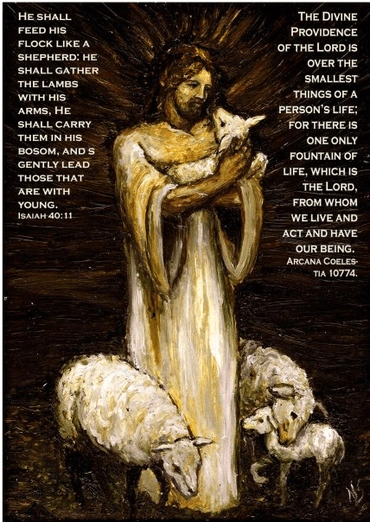529. Then the temple of God was opened in heaven, and the ark of His covenant was seen in His temple. (11:19) This symbolizes the New Heaven, in which the Lord is worshiped in His Divine humanity, and where people live in accordance with the Ten Commandments, which constitute the two essential elements of the New Church that are the means of conjunction.
The temple of God symbolizes the Lord's Divine humanity, also heaven where angels dwell, and likewise the church on earth. To be shown that the temple of God has these three symbolic meanings, and that the three cannot be separated, see no. 191. Here, however, the temple of God symbolizes the Lord in His Divine humanity in heaven where angels dwell, because it is said to be the temple of God in heaven. The ark in the temple means the Ten Commandments, for the ark had as its sole contents the two tables on which the Ten Commandments were written. 1
The temple's being opened means, symbolically, that these two, the Divine humanity and the Ten Commandments, which are the two essential elements of the New Church, are now visible, and that they became visible after the evil were cast into hell (no. 528). The ark is called the ark of His covenant in His temple because a covenant symbolizes conjunction, as we will see below. But first we must say something about the Ten Commandments.
[2] What nation in the entire world does not know that it is evil to kill, commit adultery, steal, and bear false witness? If nations did not know this and enact laws to keep people from doing these things, it would be all over with them. For society, the republic, or kingdom would collapse without these laws.
Who can suppose that the Israelite nation was so stupid in comparison to all other nations as not to know that such actions are evil? One may wonder, therefore, why these laws, being so universally known throughout the whole world, were promulgated by Jehovah Himself from Mount Sinai, attended by the great miracle they were, and written, moreover, with His finger.
But listen, they were promulgated by Jehovah with such a great miracle and written with His finger in order that people might know that these laws are not only civil and moral laws, but also spiritual laws, and that to disobey them is not only to do evil to one's fellow citizen and to society, but is also to sin against God. Their promulgation by Jehovah from Mount Sinai made them therefore laws of religion. For it is evident that whatever Jehovah God commands, He commands to make it a matter of religion, so that it must be obeyed for His sake, and for a person's own sake, that he may be saved.
[3] Because these laws were the first elements of the church to be established by the Lord with the Israelite nation, and because they embrace in brief summary everything having to do with religion which makes possible a conjunction of the Lord with a person and of a person with the Lord, therefore they were so holy that nothing was more holy.
That they were so very holy can be seen from the following: That Jehovah Himself, that is to say, the Lord, descended in fire; that the mountain then smoked and quaked; and that this was attended by thunderings, lightnings, a thick cloud, and the sound of a trumpet (Exodus 19:16, 18, Deuteronomy 5:22-26). That before Jehovah descended, the people readied themselves and sanctified themselves for three days (Exodus 19:10-11, 15). That in the Temple at Jerusalem the Ark constituted the inner sanctuary (1 Kings 6:19ff., 8:3-9). That the tablets on which the Law was written were called the tablets of the covenant, and because of them the Ark was called the ark of the covenant, with the Law itself being called the covenant (Numbers 10:33, Deuteronomy 4:13, 23; 5:2-3; 9:9, Joshua 3:11, 1 Kings 8:19, 21, and elsewhere).
The Law's being called a covenant symbolizes conjunction. The reason is that covenants are made for the sake of love, friendship, and association, thus for the sake of conjunction. That is why we find it said of the Lord that He will be "a covenant to the people" (Isaiah 42:6; 49:8), and He is called "the Messenger of the covenant" (Malachi 3:1). His blood also is called "the blood of the covenant" (Matthew 26:28, cf. Zechariah 9:11, Exodus 24:4-10). And therefore the Word is called the Old and New Testaments or Covenants.
Footnotes:







